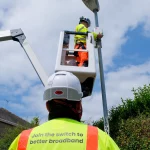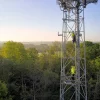G.fast networks of the future will be with us sooner than you think – Guest Editorial
In a bid to deliver high speeds and more capacity to end users, ISPs are turning to that final stretch of copper to make ultrafast broadband a reality today. Tackling the last mile of the network that takes us right to the premises will unlock the extra bandwidth that consumers now expect for streaming content and practical communications applications.
One solution enabling the industry to deliver on this is Gfast – the broadband access technology that brings ultrafast broadband via existing copper networks. This creates a viable option to bring high-speed broadband, and the new services that this enables, to locations that cannot be reached by other access methods such as fiber, due to geographical terrain or low economic viability.
The most attractive part of this gigabit-class technology is that it delivers these high speeds without the need to either re-wire or disrupt existing premises or perform costly new construction work in and to premises – that in themselves can require lengthy civil works approval. For end-users, self-installation is also made possible.
Advertisement
By creating a financially viable milestone on the way to an all fiber strategy it will accelerate the availability of high speed Internet services for those who would otherwise have to wait for many years. Simply put, Gfast brings ultrafast broadband to more users by lowering cost of deployment. Gfast promises to cost-effectively deliver bandwidth-intensive consumer applications, such as cloud-based applications and 4K Ultra High Definition to homes and premises. Gfast can also help operators meet their own broadband targets by expanding the footprint of existing fiber networks. The latest versions of this ITU-T copper technology can reach two gigabits per second making it a strong candidate for multi-tenant buildings. Most consumers and small businesses will see almost every application being satisfied by 100-200 megabit per second Gfast services.
Building on lessons learned from DSL and important work already carried out around Gfast standardization, the industry will avoid difficulties experienced with proprietary products during the initial DSL roll out. Gfast also has other interesting features such as reverse power feed to further reduce installation costs.
The standardization story so far
Working in accordance with the ITU, which set the first standard for G.fast in 2014, the Broadband Forum has been driving this work.
A rigorous testing and certification program run by the University of New Hampshire InterOperability Lab (UNH-IOL) was launched last year and has quickly made an impact, with 12 companies now offering more than 40 combinations of certified interoperable products. Its Gfast Council was also formed to organize and disseminate the expertise and experience of the Gfast market to facilitate the rapid deployment of the innovative access technology and demonstrate how Gfast fits into the bigger gigabit broadband picture.
Advertisement
Basic performance, each system’s ability to operate in noise environments and implement mitigation features is also analyzed, while spectrum control is verified to conform to regional regulatory requirements and other requirements. The Forum also hosts regular test events known as Plugfests, with the next sessions due to take place in August and November 2018.
More recently, work addressing Gfast over coax has made great progress, increasing performance requirements in the long run. Several documents, including intone on Gfast bonding, have also passed the group’s final ballot. This is particularly significant, as it allows service providers to validate Gfast bonding performance to push higher speeds over long distances. Work on MGfast, – the next phase of Gfast – has also been launched with the addition of initial service provider requirements.
The rise of hybrid networks
This work has seen operators’ confidence around the technology grow and the time-to-market accelerate, but this is not only due to the progress being made on standardization.
Deploying a Hybrid Access Network is another prominent project being pursued by the Forum to address the last few meters of the copper network and deploy fiber deeper than ever. Hybrid access enables converged carriers the opportunity to leverage both wireless and wireline assets to provide high bandwidth services and increased reliability. It also opens up additional options as to how customers in challenging locations are served.
Using Gigabit Passive Optical Networks (GPON), fiber can be fast and affordable – particularly when built correctly with standardized management in mind. Signal loss and strain can also be monitored through remote physical layer monitoring. Marrying it with Gfast by leveraging that all important existing physical infrastructure with FTTH pushes fiber within a few meters of the end-user for improved speeds, performance and easy management of the network.
Advertisement
Looking to the future
Gfast clearly has an important role to play in our future networks, so what’s next for the technology? At the Forum, we’re discussing a potential next phase of the Gfast specification which includes using multipair bonded Gfast itself as the backhaul for Gfast customer connections. Work on a second edition of a performance monitoring specification has also been given the green light.
Standardization and interoperability are at the heart of ensuring that Gfast will be widely accepted. Operators can sleep easy knowing that the use of a standardized interoperable products rather than proprietary solutions have been learned well for this copper technology.
Now that the last few meters are in sight and the promise of high speeds and more capacity are within reach, collaboration across the industry on this important work around Gfast is more crucial than ever. 2019 will soon be on the horizon, and with continued interoperability, so will a standardized Gfast that is capable of the high speeds consumers are craving.
— Robin Mersh, CEO of the Broadband Forum.
Robin has worked in the telecoms industry for over 18 years, starting at Cable & Wireless and then BT. Robin is now CEO of the Broadband Forum, which is a non-profit industry organisation that focuses upon engineering better broadband networks. Find me on Twitter and Linkedin.
« ISP BT Hike Premium Email Price by 50% for non-Broadband Users
ISP BT Launch New 9 Month Broadband Packages for UK Students »
















































Comments are closed